Prenatal Diet and Infant Growth From Birth to Age 24 Months
- PMID: 39570591
- PMCID: PMC11582932
- DOI: 10.1001/jamanetworkopen.2024.45771
Prenatal Diet and Infant Growth From Birth to Age 24 Months
Abstract
Importance: Being born either small for gestational age (SGA) or large for gestational age (LGA) and experiencing rapid or slow growth after birth are associated with later-life obesity. Understanding the associations of dietary quality during pregnancy with infant growth may inform obesity prevention strategies.
Objective: To evaluate the associations of prenatal dietary quality according to the Healthy Eating Index (HEI) and the Empirical Dietary Inflammatory Pattern (EDIP) with infant size at birth and infant growth from birth to age 24 months.
Design, setting, and participants: This cohort study used data from birthing parent-child dyads in 8 cohorts participating in the Environmental influences on Child Health Outcomes program between 2007 and 2021. Data were analyzed from March 2021 to August 2024.
Exposures: The HEI and the EDIP dietary patterns.
Main outcomes and measures: Outcomes of interest were infant birth weight, categorized as SGA, reference range, or LGA, and infant growth from birth to ages 6, 12, and 24 months, categorized as slow growth (weight-for-length z score [WLZ] score difference <-0.67), within reference range (WLZ score difference -0.67 to 0.67), or rapid (WLZ score difference, >0.67).
Results: The study included 2854 birthing parent-child dyads (median [IQR] maternal age, 30 [25-34] years; 1464 [51.3%] male infants). The cohort was racially and ethnically diverse, including 225 Asian or Pacific Islander infants (7.9%), 640 Black infants (22.4%), 1022 Hispanic infants (35.8%), 664 White infants (23.3%), and 224 infants (7.8%) with other race or multiple races. A high HEI score (>80), indicative of a healthier diet, was associated with lower odds of LGA (adjusted odds ratio [aOR], 0.88 [95% CI, 0.79-0.98]), rapid growth from birth to age 6 months (aOR, 0.80 [95% CI, 0.37-0.94]) and age 24 months (aOR 0.82 [95% CI, 0.70- 0.96]), and slow growth from birth to age 6 months (aOR, 0.65 [95% CI, 0.50-0.84]), 12 months (aOR, 0.74 [95% CI, 0.65-0.83]), and 24 months (OR, 0.65 [95% CI, 0.56-0.76]) compared with an HEI score 80 or lower. There was no association between high HEI and SGA (aOR, 1.14 [95% CI, 0.95-1.35]). A low EDIP score (ie, ≤63.6), indicative of a less inflammatory diet, was associated with higher odds of LGA (aOR, 1.24 [95% CI, 1.13-1.36]) and rapid infant growth from birth to age 12 months (aOR, 1.50 [95% CI, 1.18-1.91]) and lower odds of rapid growth to age 6 months (aOR, 0.77 [95% CI, 0.71-0.83]), but there was no association with SGA (aOR, 0.80 [95% CI, 0.51-1.25]) compared with an EDIP score of 63.6 or greater.
Conclusions and relevance: In this cohort study, a prenatal diet that aligned with the US Dietary Guidelines was associated with reduced patterns of rapid and slow infant growth, known risk factors associated with obesity. Future research should examine whether interventions to improve prenatal diet are also beneficial in improving growth trajectory in children.
Conflict of interest statement
Figures
References
Publication types
MeSH terms
Grants and funding
- UH3 OD023275/OD/NIH HHS/United States
- UH3 OD023249/OD/NIH HHS/United States
- UH3 OD023286/OD/NIH HHS/United States
- UG3 OD035513/OD/NIH HHS/United States
- UG3 OD035543/OD/NIH HHS/United States
- UG3 OD035517/OD/NIH HHS/United States
- UH3 OD023332/OD/NIH HHS/United States
- UG3 OD035532/OD/NIH HHS/United States
- UG3 OD035533/OD/NIH HHS/United States
- UH3 OD023253/OD/NIH HHS/United States
- UH3 OD023349/OD/NIH HHS/United States
- UH3 OD023285/OD/NIH HHS/United States
- UG3 OD035526/OD/NIH HHS/United States
- UG3 OD035508/OD/NIH HHS/United States
- UH3 OD023248/OD/NIH HHS/United States
- P30 ES010126/ES/NIEHS NIH HHS/United States
- UG3 OD035542/OD/NIH HHS/United States
- UG3 OD035537/OD/NIH HHS/United States
- UH3 OD023287/OD/NIH HHS/United States
- UH3 OD023365/OD/NIH HHS/United States
- UH3 OD023288/OD/NIH HHS/United States
- UH3 OD023337/OD/NIH HHS/United States
- UH3 OD023251/OD/NIH HHS/United States
- UG3 OD035540/OD/NIH HHS/United States
- U24 OD023382/OD/NIH HHS/United States
- UH3 OD023389/OD/NIH HHS/United States
- U2C ES026542/ES/NIEHS NIH HHS/United States
- UG3 OD035518/OD/NIH HHS/United States
- P30 ES036084/ES/NIEHS NIH HHS/United States
- UH3 OD023320/OD/NIH HHS/United States
- UH3 OD023305/OD/NIH HHS/United States
- UG3 OD035519/OD/NIH HHS/United States
- UG3 OD035529/OD/NIH HHS/United States
- U24 ES028533/ES/NIEHS NIH HHS/United States
- UG3 OD035528/OD/NIH HHS/United States
- UH3 OD023272/OD/NIH HHS/United States
- U2C ES030851/ES/NIEHS NIH HHS/United States
- UG3 OD035509/OD/NIH HHS/United States
- UH3 OD023290/OD/NIH HHS/United States
- UH3 OD023342/OD/NIH HHS/United States
- U2C ES026555/ES/NIEHS NIH HHS/United States
- UG3 OD035550/OD/NIH HHS/United States
- UH3 OD023318/OD/NIH HHS/United States
- UH3 OD023347/OD/NIH HHS/United States
- U24 OD035523/OD/NIH HHS/United States
- UG3 OD035546/OD/NIH HHS/United States
- UG3 OD035521/OD/NIH HHS/United States
- U2C ES026561/ES/NIEHS NIH HHS/United States
- UH3 OD023279/OD/NIH HHS/United States
- UH3 OD023348/OD/NIH HHS/United States
- UG3 OD035536/OD/NIH HHS/United States
- UG3 OD035527/OD/NIH HHS/United States
- UH3 OD023282/OD/NIH HHS/United States
- U2C ES030857/ES/NIEHS NIH HHS/United States
- K01 AI153558/AI/NIAID NIH HHS/United States
- UH3 OD023271/OD/NIH HHS/United States
- UG3 OD035544/OD/NIH HHS/United States
- U2C OD023375/OD/NIH HHS/United States
- P30 DK056350/DK/NIDDK NIH HHS/United States
- UH3 OD023244/OD/NIH HHS/United States
- U2C ES030859/ES/NIEHS NIH HHS/United States
- UH3 OD023328/OD/NIH HHS/United States
- R24 ES028533/ES/NIEHS NIH HHS/United States
- U2C ES026533/ES/NIEHS NIH HHS/United States
- UH3 OD023289/OD/NIH HHS/United States
- UH3 OD023268/OD/NIH HHS/United States
- U24 OD023319/OD/NIH HHS/United States
- UH3 OD023313/OD/NIH HHS/United States
- UH3 OD023344/OD/NIH HHS/United States
- UG3 OD035516/OD/NIH HHS/United States
- U24 ES026539/ES/NIEHS NIH HHS/United States



